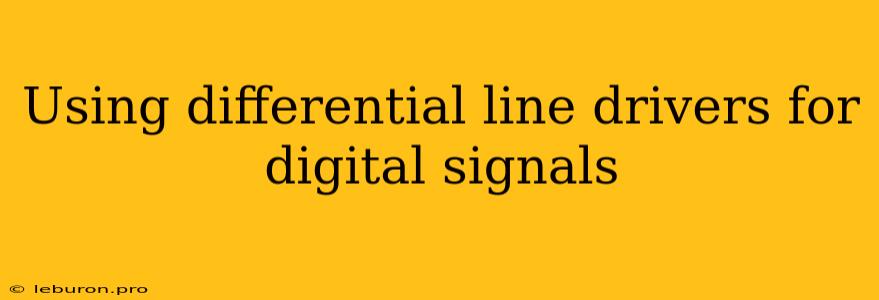In the realm of high-speed digital communication, ensuring signal integrity is paramount. As data rates soar, traditional transmission lines can struggle to maintain signal quality over longer distances, leading to signal degradation and data errors. This is where differential line drivers emerge as a powerful solution, effectively mitigating these challenges and enabling reliable, high-speed data transfer. By employing a balanced transmission approach, differential line drivers enhance noise immunity, reduce crosstalk, and extend the reach of digital signals, making them indispensable for a wide range of applications.
Understanding Differential Line Drivers:
Differential line drivers, often referred to as "diff drivers," are specialized integrated circuits (ICs) designed to transmit digital signals in a balanced fashion. Unlike single-ended signaling, where data is carried on a single line referenced to ground, differential line drivers employ two separate lines, transmitting complementary signals (one high while the other is low). This balanced approach provides several key advantages:
Enhanced Noise Immunity:
One of the primary benefits of differential line drivers is their superior noise immunity. Since both lines carry complementary signals, external noise affecting one line is largely canceled out by the other, resulting in a cleaner signal at the receiver end. This is particularly crucial in noisy environments or high-frequency applications where electromagnetic interference (EMI) can significantly impact signal integrity.
Reduced Crosstalk:
Crosstalk, the unwanted coupling of signals between adjacent lines, can be a major issue in high-density digital systems. Differential line drivers effectively minimize crosstalk by utilizing a balanced transmission scheme. Since both lines carry signals of equal but opposite polarities, any crosstalk introduced onto one line is canceled out by the other, ensuring a cleaner signal at the receiver.
Extended Signal Reach:
Differential line drivers enable longer signal transmission distances compared to single-ended signaling. This is attributed to their improved noise immunity and reduced crosstalk, allowing for cleaner and less degraded signals to travel further. As data rates climb, the ability to extend signal reach is critical for achieving optimal performance and reducing the need for repeaters or signal regeneration.
How Differential Line Drivers Work:
Differential line drivers operate by converting a single-ended input signal into a balanced output signal. The input signal is applied to the driver's non-inverting input, while the inverting input is typically tied to a reference voltage (usually ground). The driver then generates two outputs, one inverting and one non-inverting, with equal but opposite polarities.
These outputs are then transmitted over two separate lines, forming a differential pair. The differential receiver, located at the destination, compares the voltage difference between the two lines to determine the data state. This voltage difference, known as the differential voltage, is effectively immune to common-mode noise, which affects both lines equally.
Key Features and Considerations:
Differential line drivers come with a variety of features and characteristics that cater to specific application needs. Key considerations include:
- Output Voltage Swing: The voltage swing of the driver determines the signal amplitude, affecting signal quality and reach. Higher voltage swings offer improved noise immunity but may consume more power.
- Output Impedance: The impedance of the driver output influences signal reflections and matching. Proper impedance matching is essential for optimal signal integrity.
- Data Rate: Differential line drivers are designed for specific data rates, ranging from low-speed to ultra-high-speed applications. Choosing the right driver for the desired data rate is crucial.
- Power Consumption: The power consumption of the driver is a significant factor, particularly in battery-powered devices or systems where power efficiency is critical.
- Operating Temperature Range: The operating temperature range defines the environment in which the driver can operate reliably. Industrial applications often require drivers with extended temperature ranges.
Applications of Differential Line Drivers:
Differential line drivers find widespread use in various applications, including:
- High-Speed Data Communication: From data centers to high-performance computing, differential line drivers are essential for reliable data transfer over long distances and high bandwidth networks.
- Consumer Electronics: Modern smartphones, tablets, and laptops rely on differential line drivers for high-speed connectivity through interfaces such as USB, PCIe, and HDMI.
- Automotive: As vehicles increasingly incorporate advanced digital features, differential line drivers play a vital role in transmitting data between various sensors, control units, and infotainment systems.
- Industrial Automation: In industrial environments with demanding conditions, differential line drivers provide robust signal transmission for critical applications like robotics, process control, and machine-to-machine communication.
- Medical Devices: Medical devices often require reliable and accurate data transmission, and differential line drivers offer the noise immunity and signal integrity necessary for sensitive applications.
Conclusion:
Differential line drivers are essential components for ensuring signal integrity in high-speed digital communication systems. Their balanced transmission approach provides superior noise immunity, reduced crosstalk, and extended signal reach, enabling reliable data transfer over longer distances. From high-performance computing to consumer electronics and industrial automation, differential line drivers continue to play a critical role in driving innovation and advancing the capabilities of digital technologies. By understanding the principles and benefits of differential line drivers, engineers can design and implement high-speed digital systems that meet the demanding requirements of modern applications.
